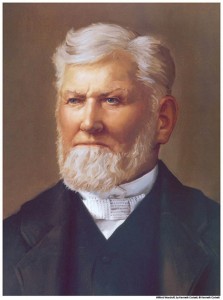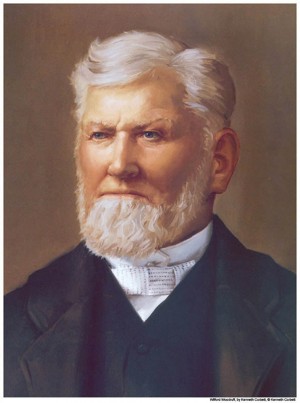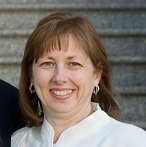Wilford Woodruff was born on March 1, 1807, in Farmington, Connecticut, to Aphek and Beulah Woodruff, who also had 3 other sons. When Wilford was just 15 months old, his mother died of spotted fever. After approximately three years, his father married Azubah Hart, who would bear six more children.
 Wilford learned how to work hard from his father by working on the family farm and helping his father at the sawmill. He loved being with his parents and siblings – whether it be fishing with his brothers, learning gospel teachings from his stepmother, or working side by side with his father, he would always remember that the greatest joys in life were linked to his parents and siblings.
Wilford learned how to work hard from his father by working on the family farm and helping his father at the sawmill. He loved being with his parents and siblings – whether it be fishing with his brothers, learning gospel teachings from his stepmother, or working side by side with his father, he would always remember that the greatest joys in life were linked to his parents and siblings.
At a very young age, Wilford was searching for the true Church. He said, “I believed…that the Church of God would be reestablished upon the earth, and I should live to see it.” Wilford attended numerous religious meetings in the area near his home. At one meeting, he was given permission to speak. With more than forty ministers from various churches present, young Wilford stood and said: “My friends, will you tell me why you don’t contend for the faith once delivered to the Saints? Will you tell me why you don’t contend for that Gospel that Jesus Christ taught, and that His Apostles taught? Why do you not contend for that religion that gives unto you power before God, power to heal the sick, to make the blind to see, the lame to walk, and that gives you the Holy Ghost and those gifts and graces that have been manifest from the creation of the world? Why do you not teach the people those principles that the ancient Patriarchs and Prophets taught while they were clothed with the revelations of God? They had the administrations of angels; they had dreams and visions, and constant revelation to guide and direct them in the path in which they should walk.”
Needless to say, the ministers were astonished at such words coming from such a young man. The presiding minister commented by saying, “…You would be a very smart man, and a very useful man in the earth, if you did not believe all those foolish things. These things were given to the children of men in the dark ages of the world…Today, we live in the blaze of the glorious gospel light, and we do not need those things.” With that said, Wilford retorted, “Then give me the dark ages of the world; give me those ages when men received these principles.”
Wilford continued to study the Bible, and searched continuously for the true Church on the earth that taught and lived by the teachings of the Savior. At the age of 26, Wilford was privileged to be in another meeting with two missionaries who claimed to be the true messengers of Jesus Christ and had come to proclaim His gospel. They taught those in attendance and finished by bearing their testimonies. Elder Pulsipher, one of the missionaries, encouraged those in attendance to comment and ask questions. Wilford needed no further encouragement; he immediately stood on a bench, not knowing what he was going to say. As he stood and looked around at his neighbors and friends, he felt impressed to say, “I want you to be careful what you say as touching these men…and their testimony, for they are servants of God, and they have testified unto us the truth – principles that I have been looking for from my childhood.”1
Wilford knew without a doubt that these two missionaries were speaking the truth and that this was what he had been waiting for all his life. He was baptized and confirmed a member of The Church of Jesus Christ of Latter-day Saints on December 31, 1833.
Wilford’s life was plagued with numerous accidents. Later in his life, as he pondered on these mishaps, he never missed expressing his gratitude to the Lord for preserving his life. He said, “I have broken both legs – one in two places – both arms, my breast bone and three ribs, and had both ankles dislocated. I have been drowned, frozen, scalded and bit by a mad dog – have been in two water wheels under full head of water – have passed through several fits of sickness, and encountered poison in its worst forms – have landed in a pile of railroad ruins – have barely been missed by the passing bullets, and have passed through a score of other hair-breadth escapes…. [And each has proved] miraculous to me, that with all the injuries and broken bones which I have had, I have not a lame limb, but have been enabled to endure the hardest labor, exposures and journeys…the protection and mercy of God has been over me, and my life thus far has been preserved; for which blessings I feel to render the gratitude of my heart to my Heavenly Father, praying that the remainder of my days may be spent in His service and in the building up of His kingdom.” 2 Many times he mentioned that he felt there was a great battle for his life between the adversary and the Lord. He knew that he was foreordained to a great work and that the Lord would protect him and guide him to it.
Wilford desired more than anything to preach the gospel to others. He said, “I knew the Gospel…was true, and of such great value that I wanted to tell it to the people who had not heard it. It was so good and plain, it seemed to me I could make the people believe it.” He was called on a mission to the southeastern United States in 1834, after he had been a member of the Mormon Church barely a year.
This mission was not to be easy. His companion stayed with him through the early trials of the mission, but soon became discouraged and returned home. Left alone, Wilford prayed for help to continue his missionary labors in an unfamiliar land and received it. In 1836, he completed his missionary service in the southeastern United States and returned home to Kirtland. He recorded in his journal that in “1835 and 1836 [he] had…held 323 meetings, organized 4 branches of the [Mormon] Church, baptized 70 people and confirmed 62, performed 11 priesthood ordinations, and healed 4 people by the laying on of hands and that he had been delivered from the hands of 6 different mobs.”3
President Heber J. Grant, the seventh President of the Mormon Church, stated that President Woodruff was “perhaps…the greatest converter of men we have ever had in the Church.” President Woodruff, through his missions in the eastern states, the South, the Fox Islands, and the British Isles, would convert more than 2,000 people.
After returning home, he found that the trials at home would be arduous as well. Many members of the Mormon Church had turned against the Prophet Joseph Smith and the teachings of the Savior. However, Wilford Woodruff remained true to the Prophet through this trial in the Church’s history and continued on with a determination to preach the gospel.
In 1838, Doctrine and Covenants 118:6 was revealed to the Prophet Joseph Smith. In this revelation, Wilford was called to be an Apostle of the Lord Jesus Christ, to serve in the Quorum of the Twelve. He would continue in this calling until 1889, when he was called to be the fourth President of The Church of Jesus Christ of Latter-day Saints.
Approximately two years after the martyrdom of the prophet Joseph Smith, the members were forced to leave their homes in Nauvoo and establish temporary homes in Winter Quarters, Nebraska. Departing from Winter Quarters, Elder Woodruff helped lead the pioneers to the Salt Lake Valley, where they arrived on July 24, 1847. As part of the first company of pioneers, he transported President Brigham Young, who was then President of the Mormon Church. President Young was quite ill on the later part of the journey, but as they surveyed the valley before them, he proclaimed: “…This is the right place, drive on.”
After the members had settled in the Salt Lake Valley, Elder Woodruff’s responsibilities no longer involved full-time missions. His duties included meeting with those who visited the area, serving in the local government as a legislator, working to irrigate and cultivate the land, and developing crops and farming methods. He visited regularly with members of the Church in settlements in Utah, Arizona, and Idaho, preaching the gospel and encouraging the members in their duties.
Elder Woodruff served as the Assistant Church Historian and later the Church Historian for the Mormon Church while an Apostle. This responsibility required a tremendous amount of time. He believed that the history of the Church was vital, in that it would remain through time and in eternity. He also believed that keeping a personal journal was just as important in preserving the history of an individual; he began writing his own journal in 1835 and continued on until his death, with over sixty-three years of entries in his personal journals. His writings provide a detailed and reliable account of many revelations received by himself and others, including Joseph Smith, and of events that transpired in the Church.
The work ethic he learned from his father continued on throughout his life. Elder Franklin Richards of the Quorum of the Twelve Apostles said that Elder Woodruff was “noted for his activity, industry, and physical endurance. Though not a large man, he was able to perform labors that would have prostrated men of ordinary physique.”4
Elder Woodruff was sustained as Prophet, Seer, and Revelator on April 7, 1889, after the death of President John Taylor. Feeling the burden of leading the entire Church, President Woodruff recorded in his journal the following: “This places me in a very peculiar situation, a position I have never looked for during my life. But in the providence of God, it is laid upon me, and I pray God my Heavenly Father to give me grace equal to my day. It is a high and responsible position for any man to occupy and a position that needs great wisdom…O Lord God Almighty, for thou hast certainly chosen the weak things of the world to perform thy work on the earth. May [I] be prepared for whatever awaits me on [this] earth and have power to perform whatever is required at [thy] hands by the God of Heaven…”5
Four temples were built and dedicated in the Utah Territory during his lifetime – in St. George, Logan, Manti, and Salt Lake City. As President of the Mormon Church, he offered the dedicatory prayers for the Manti and Salt Lake temples.
As President, he repeatedly bore testimony of the Restoration of the Gospel. He was the last living man to have served as an Apostle with the Prophet Joseph Smith, and he felt a great urgency in leaving with the members his testimony of the Prophet Joseph and his mission on earth—that of Restoring the Gospel of Jesus Christ to the earth in the latter days.
One of the most turbulent issues in the history of the Mormon Church was that of plural marriage. In the late 1880s, the Church continued to observe plural marriage in obedience to the Lord’s commandment to the prophet Joseph Smith. However, the United States government had recently passed a law prohibiting the practice. The Church would endure harsh penalties for the violation of the law, including confiscation of Church property and the denial of basic civil rights. Numerous appeals were made, but to no avail.
President Woodruff prayed for the members of the Church and prayed to know what the Lord would have him do. Revelation was received through the Prophet, and the members were counseled to cease the practice of plural marriage. On September 24, 1890, this became known as the Manifesto—an inspired statement that remains the foundation of the Church’s position on the subject of plural marriage. President Woodruff declared his intention to submit to the laws of the land and testified that the Church had ceased teaching the practice of plural marriage.6
1 “Journal of Wilford Woodruff”, introduction
2 “History of Wilford Woodruff, Chapter of Accidents, 1865, p.392
3 “Journal of Wilford Woodruff”, summaries of 1835-36
4 “Wilford Woodruff”, Improvement Era, Oct 1898, p.865
5 “Journal of Wilford Woodruff”, July 25, 1887
6 Doctrine and Covenants, Official Declaration 1
About Anita Stansfield
Anita Stansfield began writing at the age of sixteen, and her first novel was published sixteen years later. For more than fifteen years she has been the number-one best-selling author of women’s fiction in the LDS market. Her novels range from historical to contemporary and cover a wide gamut of social and emotional issues that explore the human experience through memorable characters and unpredictable plots. She has received many awards, including a special award for pioneering new ground in LDS fiction, the Lifetime Achievement Award from the Whitney Academy for LDS Literature, and also a Lifetime Achievement Award from her publisher, Covenant Communications. She has fifty-six published books. Anita is the mother of five, and has three grandchildren.



 Watch a video about the restoration of the gospel on lds.org
Watch a video about the restoration of the gospel on lds.org
This is my great great great great grandfather i can’t believe it
The art is by Ken Corbett kencorbettart.com